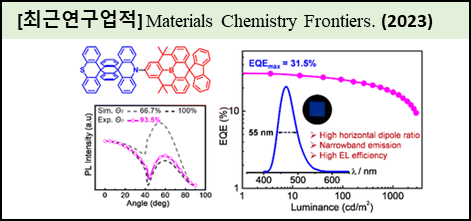|
Author list |
Young Hoon Lee, Jeoungmin Ji, Thi Quyen Tran, Taehwan Jaehoon Jung, Youngil Lee, Seunghyup Yoo and Min Hyung Lee |
|
Abstract
(superscript and subscript cannot be allowed.) |
Developing thermally activated delayed fluorescence (TADF) emitters showing high horizontal transition dipole orientation and molecular rigidity is crucial for enhancing the color purity and performance of deep-blue organic light-emitting diodes (OLEDs). Here, we report two linearly expanded TADF emitters, O-tsAC-BAsBP (1) and S-tsAC-BAsBP (2), based on a tri-spiral acridine donor and a spiro-fluorenyl B-heterotriangulene acceptor. These emitters exhibit deep-blue emissions, with peaks centered at 458–467 nm for 1 and 462–469 nm for 2, respectively, in the host films, with high photoluminescence quantum yields, small singlet–triplet energy splitting (ΔEST < 0.05 eV), and short delayed fluorescence lifetimes (τd < 2 μs). Theoretical studies demonstrate that effective spin–orbit coupling between the charge transfer singlet (1CT) and acceptor-centered local triplet (3LE) excited states accelerates the reverse intersystem crossing (RISC) process, resulting in a high RISC rate constant of ∼106 s−1. Notably, both emitters exhibit very high horizontal dipole orientation ratios (Θ‖) of ∼93% in their doped host films. Owing to the outstanding TADF characteristics and high Θ‖ values, TADF-OLEDs incorporating emitters 1 and 2 achieve high maximum external quantum efficiencies of 27.4% and 31.5%, respectively, in the deep-blue region.
|

